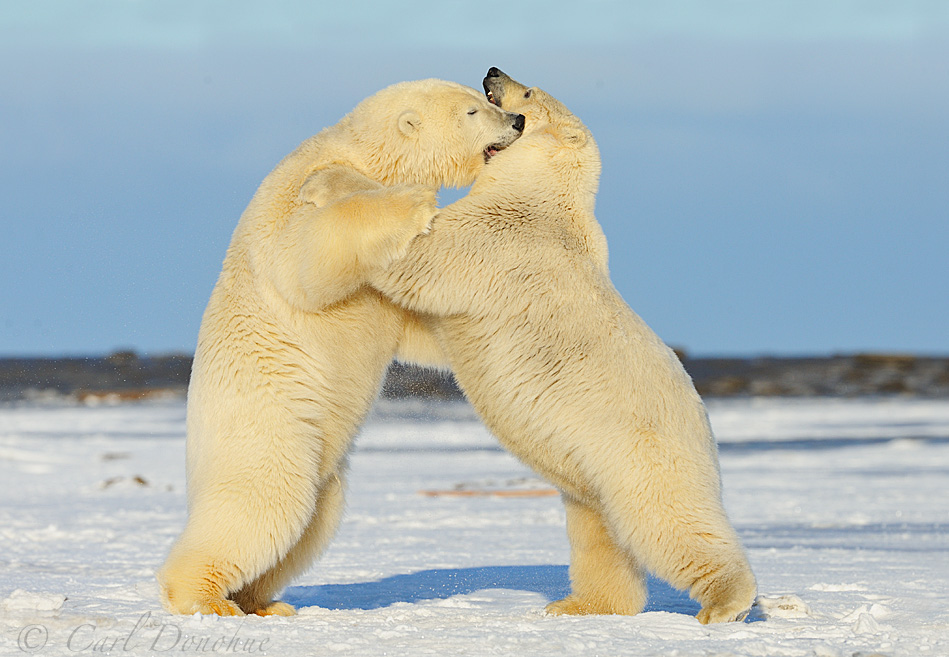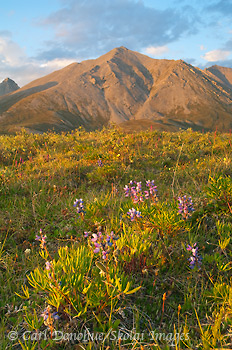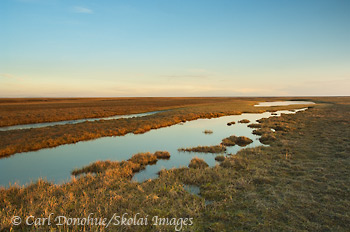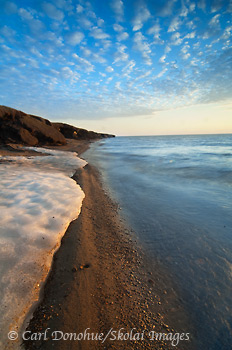Tag Archives: ANWR
Polar bear image and the Brooks Mountains Range
Polar bears at play

Polar Bear photo, Arctic Alaska
50th Anniversary of the Arctic National Wildlife Refuge
Hey Folks,
December 6, 2010, marks the 50th anniversary of the establishment of the Arctic National Wildlife Refuge, or ANWR, in Alaska. To commemorate this, and as a tribute to an amazing place, I’ve put together this slide show; 50 photos to mark the 50 years. These are all images from the Refuge, over 19 million acres of wild lands. The refuge is a treasure, home to thousands of creatures and features; the caribou herds, the Brooks Mountains, the broad coastal plain, migratory birds and countless other gifts to this world. A beautiful landscape that warrants our respect, not our exploitation.
I selected the images to present a the diversity of features and creatures that call the Refuge home, and composed and recorded the music to accompany it. I hope you enjoy it. Continue reading
Arctic National Wildlife Refuge

A small bloom of Arctic Lupine in the Brooks Mountain Range catch last light of the summer day. Land of the midnight sun, the Arctic National Wildlife Refuge, or ANWR, in arctic Alaska where the coastal plain meet the Brooks Mountain Range. Please click on the image above to view a larger version of the photo.
Hey Folks,
Another photo from the Brooks Range, and the Arctic National Wildlife Refuge.
Back in September the US F&WS (Fish and Wildlife Service) announced, as part of their Comprehensive Conservation Plan, that “the Service will conduct wilderness reviews for three Wilderness Study Areas (WSAs) for potential inclusion within the National Wilderness Preservation System. These three WSAs encompass almost all refuge lands not currently designated as wilderness”. This is good news. I’ll reiterate my favorite part of the quote: “These three WSAs encompass almost all refuge lands not currently designated as wilderness“.
There are numerous steps involved, and, if recommended by the US F&WS, approval is required by the Dept Director, the Secretary of the Interior, and the President. Then, the final decision lies with the US Congress; the actual authority to designate land as ‘wilderness’.
It’s almost comical, really; such a rigorous and formalized process to meander through in order to deem lands “wild”. Implicit in the word wild is ‘free will’ – yet not quite so wild as to be free of the rigmarole of official procedure, of course.
Anyone who suggests the 19 million acres of the Arctic National Wildlife Refuge isn’t a wilderness either hasn’t been there or is simply in denial. Perhaps I could say it more clearly this way; if the Arctic National Wildlife Refuge doesn’t qualify for ‘wilderness designation’, then we might as well remove that term from our vocabulary. Surely there is no place more deserving of such designation than the Refuge?
The “wilderness reviews” should be completed by Feb 2011, which will be followed by a released draft, more public comment, more revisions, and hopefully, a final plan and recommendation in May 2012. Apparently wilderness takes careful planning and review; it’s not simply created overnight.
A reminder that Dec 06, 2010, marks the coming anniversary of the establishment of the Refuge; I’m working on a little project for it, and should have it online soon. Stand warned. 🙂
Cheers
Carl
Photographers and icons

Dwarf fireweed (Epilobium latifolium) and the Upper Marsh Fork River of the Brooks mountain range, in the Arctic National Wildlife Refuge (ANWR), Alaska. Mid summer, this photo was taken about 2:00am. First light of the day. 🙂 Please click on the image above to view a larger version of the photo.
Hey Folks,
Recently I’ve read a few articles and posts about photography and and photographers, and particularly landscape photographers; the question of ‘shooting icons’ almost invariably comes up. For those readers here who aren’t quite sure what that is a reference to, it simply points to the regularity with which so many famous landscapes are photographed. Scenes such as Grand Teton from the Snake River Overlook, Yellowstone National Park’s Lower Falls are almost ubiquitous with landscape photography.
It’s an interesting discussion. Those kinds of locations are frequently photographed because not only are they spectacular scenes, but they’re also great to photograph; overlooks and viewpoints seemingly designed with the landscape photographer in mind. This is not true of all spectacular scenes, for a variety of reasons.
The primary reason a scene like this one, of Mount Edith Cavell and Cavell Lake in Canada’s Jasper National Park has been photographed so many more times than, say, the scene at left, is that Edith Cavell is road accessible. All the other discourse about happiness and contentment and art versus stock and following one’s creative muse and shooting your passion is simply talk; it all comes down to the pavement. If it’s off the road, it’s probably not an icon.
The question then concerns itself with the value of our pursuit; and that, like so many such questions, is entirely contextual. For some people, shooting photos that sell well is all that matters. For others, shooting photos that express some personal vision is more important. Continue reading
Happy Birthday, Arctic National Wildlife Refuge

Midnight sun on the coastal plain, Section 1002, near the Canning river. A small pond on the plain catches a the skies blue reflection. Pond and reflection, coastal plain, Arctic National Wildlife Refuge (ANWR), Alaska. Dec, 2010 marks 50 years since the federal government established the area as a national wildlife refuge. To view a larger version of this photo, please click on the image above.
Hey Folks,
Drill here? Drill now? I think not.
How about “Happy Birthday, and Cheers to the next 50 years!”
This year is the 50th anniversary of the establishment of the Arctic National Wildlife Refuge – “ANWR”, as folks like to call it. A swathe of wild land the size of South Carolina became a federally protected area in 1960, and then established as a wildlife refuge in 1980 with the passing of the Alaska National Interest Lands Conservation Act (ANILCA).
One of the most important conservation measures yet taken by this nation, the Act protects over 100 million acres of federal lands within Alaska; this single statute more than doubled the area of national park and refuge land in the country and tripled the area of federally designated wilderness. Roughly 40%, or 8 million acres, of the Arctic National Wildlife Refuge was (and is) designated wilderness. This one landscape makes up over 7% of the designated wilderness in the United States.
Next month, on Dec 6, 2010, ANWR turns 50 years old. Turn your thoughts northward, and give it a moment. Or several moments. 19 million acres of land this country gifted to itself. It’s a beautiful thing.
I’ve visited the refuge a number of times now, and each year the visit has been unimaginably rewarding. To those who’d rather see it turned into an oil well, I’d ask to what end?
Cheers
Carl
Parasitic Jaeger, Arctic National Wildlife Refuge, Alaska.

A Parasitic Jaeger (Stercorarius parasiticus) in flight over the coastal plain of the Arctic National Wildlife Refuge (ANWR), Alaska. Click the image to view a larger version of the photo.
Hey Folks,
One afternoon we hiked out around the coastal plain of the Arctic National Wildlife Refuge just because. We must’ve wandered a little close to a Jaeger nest, as this bird suddenly appeared from nowhere and made its displeasure known.
The Parasitic Jaeger is also called the Arctic Skua or the Parasitic Skua. While not a “parasite“, the bird is well known for it’s piracy of other birds’ food. Stealing food is often called “kleptoparasitism” by folks who like to use large prodigious words to describe simple, everyday stuff; scientists, for example.
Though solitary, they’ll often ‘gang up‘ on other birds to steal food. One of the folks on our trip, Steve Weaver, was witness to such an act, when he saw and photographed 4 Jaegers harassing a Red-throated loon, finally driving it from its nest and eating the eggs the loon had been defending. Amazing stuff.
The Jaeger isn’t simply a thief though – the bird also hunts for prey, such as rodents, small birds and insects – Jaeger is the German word for ‘hunter‘.
Parasitic Jaegers look kinda like a gull, but the wings and flight are more falconesque. Pelagic birds, they spend the bulk of their time at sea, coming ashore to breed. The young will often spend the first couple of years of their lives over the seas, not returning to land until they reach breeding age.
Some of you might recall the Long-tailed Jaeger photo I posted previously from a trip to the Arctic National Wildlife Refuge (ANWR) a couple of years ago. The Parasitic Jaegers are closely related, a little larger, but not so large as the Pomarine Jaeger.
Cheers
Carl
Arctic Ocean, ANWR, Alaska.

The Beaufort Sea along the coastal plain of the Arctic National Wildlife Refuge (ANWR). The Arctic Ocean sea ocean, after spring breakup, rests on the beach. Melting permafrost in the bluffs signals warming temperatures. Arctic Ocean, Coastal Plain, ANWR, Alaska. Click for a larger photo.
Hey Folks,
Another photo from our recent trip to the Arctic National Wildlife Refuge and the Beaufort Sea. I hiked from our final camp across the coastal plain (well, across part of the plain, not the whole thing) with Steve Weaver hoping to photograph some of the icebergs we’d seen the previous day along the shoreline. Unfortunately, strong southerly winds had blown almost all the ice out to sea, and we were largely thwarted. This patch of ice, however, had been resting on shore, stranded when the tide rolled out, and we made a few images.
Coastlines are such dynamic landscapes, and in the Arctic particularly so. They can change drastically in a day or less, and do so frequently.
This photo was taken around 1:15am .. maybe later. I think Steve and I arrived back at camp around 4:00am, and I went to bed at nearly 5:00am. up at 10:00am-ish to break camp, roll the raft, and wait for a bush plane. We arrived, finally, in Coldfoot, around 5:30pm,(the temp was 90deg F, a start contrast from the Arctic Ocean we’d just left) unpacked the gear from the plane, sorted it and loaded the van, ate dinner, and hit the road, rolling into the Yukon River area stop late at night. Then up early the next morning to drive from there to Anchorage. 36 hours later it was out the door to pick up folks for the next trip to Wrangell-St. Elias National Park and Preserve. Summertime can be like that in Alaska.
I’ve been out to the Beaufort Sea here a number of times, now every time I’ve been so fortunate as to have an absolutely glorious final evening. The wind wasn’t bad at all, the bugs had quieted down, and the expansive vastness of the place really moves me. It’s a fantastic experience, to see such a harsh and rugged environment also be so sensitively fragile; the quiet tundra, the shorebirds, a whisper of air and the glowing rays of the sun, low on the horizon. After the trek back to camp I simply couldn’t go to bed, but sat for nearly 45 minutes by my tent, just watching, listening and enjoying the grace of the Arctic coastal plain. It’s a phenomenal place.
The bluffs on the left of the frame, like Castles Made of Sand, slowly slip into the sea – eventually.
Cheers
Carl